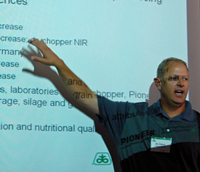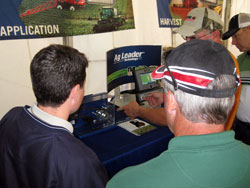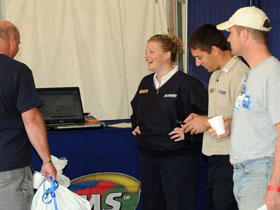 NASA posted a recent story on how farmers are downloading free satellite images to gain field information. It highlights how one organic farmer spots weed problems, determines hail impact and even checks pasture rotation timing.
NASA posted a recent story on how farmers are downloading free satellite images to gain field information. It highlights how one organic farmer spots weed problems, determines hail impact and even checks pasture rotation timing.
Noreen Thomas’ farm looks like a patchwork quilt. Fields change hue with the season and with the alternating plots of organic wheat, soybeans, corn, alfalfa, flax, or hay.
Thomas enjoys this view from hundreds of miles above Earth’s surface — not just for the beauty, but the utility. She is among a growing group of Midwest farmers who rely on satellite imagery from Landsat to maximize their harvest and minimize damage to their fields. It’s become another crucial tool like their tractors and sprinklers.
“Our farm is unconventional – we grow food and breed animals using all-natural approaches,” said Thomas of her certified organic farm in Moorhead, Minnesota, where they also grow heirloom tomatoes, lettuce, squash, and peas. “So we’re happy to use unconventional methods to solve problems and keep our crops healthy.”
For $25 and an hour’s drive to the Grand Forks campus of the University of North Dakota (UND), Noreen and Lee Thomas took a one-day class on how to download and interpret satellite images, like those provided by NASA and the U.S. Geological Survey (USGS).
Downloading the latest images takes mere minutes on the Digital Northern Great Plains system, a free Web-based tool developed by NASA-funded researchers in the Upper Midwest Aerospace Consortium. Thomas punches in GPS coordinates of the area she’d like to see, and moments later she has a bumper crop of information and images.
To the untrained eye, the false-color images appear a hodge-podge of colors without any apparent purpose. But Thomas is now trained to see yellows where crops are infested, shades of red indicating crop health, black where flooding occurs, and brown where unwanted pesticides land on her chemical-free crops.
The images help the Thomases root out problems caused by Canadian thistle and other weeds. They help confirm that their crops are growing at least 10 feet from the borders of a neighboring farm – required to maintain organic certification. They can also spot the telltale signs of bottlenecking in the fields — where flooding is over-saturating crops — and monitor the impact of hail storms.
“We’d have to walk our entire 1,200 hundred-plus acres on a regular basis to see the same things we can see by just downloading satellite images,” said Thomas, who recently began providing her farm’s coordinates to her buyers in Japan. “There’s no more ideal way I know to show how healthy our crops are to someone thousands of miles away.”
Crops are not the only beneficiaries of snapshots from space. Just as remote imagery informs Thomas when it’s best to rotate crops, she can also determine when her cows need a new pasture. When the large herd of cows chews its way through the landscape, satellite images show where the cows may be overgrazing.

 Researchers are usually the first to use new technology and when it comes to agricultural crop research, precision technology has made the development of new and better genetic varieties move at a much more rapid pace than ever before.
Researchers are usually the first to use new technology and when it comes to agricultural crop research, precision technology has made the development of new and better genetic varieties move at a much more rapid pace than ever before.  One significant advancement for developing new corn silage hybrids has been on-chopper NIR, or near-infrared spectroscopy. “On-chopper NIR is a tool that we use to measure quality and yield traits for a specific silage product that we are looking at,” Curran says. “That tool gives us an immediate answer. We know exactly what’s inside that corn hybrid within 20 seconds of chopping it.” The on-chopper NIR also allows the researchers to measure nearly all of the silage in a field faster and more efficiently than they could measure small samples.
One significant advancement for developing new corn silage hybrids has been on-chopper NIR, or near-infrared spectroscopy. “On-chopper NIR is a tool that we use to measure quality and yield traits for a specific silage product that we are looking at,” Curran says. “That tool gives us an immediate answer. We know exactly what’s inside that corn hybrid within 20 seconds of chopping it.” The on-chopper NIR also allows the researchers to measure nearly all of the silage in a field faster and more efficiently than they could measure small samples.  As an Iowa farm kid who grew up loving technology (I just chose to write about it and let my brother run it on the family farm), one of my passions is talking to farmers about their technology adoption—so I can learn and write stories that help others. And over the past 28 years of covering the incredible advances we’ve all seen, the stories I’ve heard are amazing, and sometimes funny.
As an Iowa farm kid who grew up loving technology (I just chose to write about it and let my brother run it on the family farm), one of my passions is talking to farmers about their technology adoption—so I can learn and write stories that help others. And over the past 28 years of covering the incredible advances we’ve all seen, the stories I’ve heard are amazing, and sometimes funny. Yesterday I spoke with Tim Norris, owner of a successful central Ohio precision technology business called Agronomic Information Technology, based in Gambier. Norris has more than a dozen years experience installing and helping farmers and custom applicators adopt a complete range of precision farming products—from basic lightbars and excellent monitors like
Yesterday I spoke with Tim Norris, owner of a successful central Ohio precision technology business called Agronomic Information Technology, based in Gambier. Norris has more than a dozen years experience installing and helping farmers and custom applicators adopt a complete range of precision farming products—from basic lightbars and excellent monitors like  If constant RTK connection is an issue in some of your fields, Trimble has a
If constant RTK connection is an issue in some of your fields, Trimble has a  The Iowa Soybean Association On-Farm Network is hosting a yield monitor webinar tomorrow morning (Wednesday Sept. 16) from 7:30 to 8:30 am CDT.
The Iowa Soybean Association On-Farm Network is hosting a yield monitor webinar tomorrow morning (Wednesday Sept. 16) from 7:30 to 8:30 am CDT. Another
Another 

 When you visit a farm show the first question I hear asked is, “What’s new?” In the Ag Leader Technology exhibit at the Farm Progress Show Jess Ahrens answered that by telling me about the latest version of their
When you visit a farm show the first question I hear asked is, “What’s new?” In the Ag Leader Technology exhibit at the Farm Progress Show Jess Ahrens answered that by telling me about the latest version of their  John Deere’s machine guidance portfolio expands by two products, which can also be used on select non-John Deere platforms.
John Deere’s machine guidance portfolio expands by two products, which can also be used on select non-John Deere platforms.